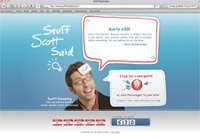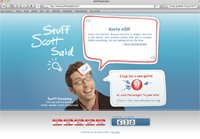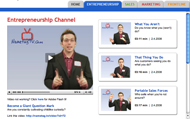 The human need to feel needed by (and valuable to) the world is about as deep as they come.
The human need to feel needed by (and valuable to) the world is about as deep as they come.
Here are some ideas to help you (and/or) your organization matter:
1. Make soaring unpreventable. The first time I heard Dave Matthews play the song he wrote for his wife called Loving Wings, I was brought to tears. The chorus goes: “I give to you my everything. You’ve given me these loving wings. And angels have all gathered round to hear me sing my love out loud.”
That’s your job: With your customers, your employees, your kids, your friends – to help them paint a picture of what they know they can achieve. In short: To give them wings. People don’t need Red Bull – they need you look them in the eye and say, “I believe in you.” How are you empowering people to become the person they were created to be?
2. Be fresh air. Unless you live in Tasmania (which, according to Weather.com, has the cleanest measured air on Earth) most of the oxygen surrounding us is stale, recycled and tastes like the Sunday morning redeye from Vegas. So, just imagine how much of an impact you could have on the environment around you if your ideas, words and actions brought even the slightest amount of freshness.
Are you saying the same thing as everyone else? Hope not. Because freshness doesn’t just matter – it makes money. However, as you tip toe along the lunatic fringe, remember what Jim Flowers says, “Carefully and deliberately consider the raves, rants, fashion, science, and art of the avant garde. Explore the world of ‘too much.’ There is a very, very fine line between goofy and prophetic.” Are your ideas stale?
3. Bring solid value. Not just talk. Not just shtick. The word “matter” comes from the Latin materia, which means, “substance.” And you owe it to the world to let it ooze out of you. If you were charged with the crime of adding value, would there be enough evidence to convict you?
4. You must teach. Teachers are heroes. And anyone can be one. The two questions are: What is the teaching you are called to do? And what’s your teaching style? Couple of choices. Through your beliefs would be good. Through your words would be great. Through your actions would be awesome. But through your personal being – now that would be positively devastating.
Not to mention remarkable, since 90% of the world teaches through the first three approaches. My best suggestion for doing so is to write, memorialize, revisit and embody the living document known as your Personal Constitution. Email me if you want to learn more. How many new students have you enrolled this week?
5. Pry your life out of the jaws of average. There’s pervasive pressure to embrace mediocrity. For the love of God, don’t give in. Wage a war against boringness. Violently refuse to become a follower of the common ways of the mediocre masses. Instead, joyfully and loudly occupy the margins.
As Seth Godin explained in an interview with Selling Power, “Mediocrity is for losers. The big win is when you refuse to settle for average and you say I’m going to give up 90% of the opportunities.” Are you vanilla?
6. Be a person of consequence. This reminds me of a gorgeous song by Jose Gonzalez called Cycling Trivialities: “Don’t know which way to turn, every trifle becoming big concerns. All this time you were chasing dreams, without knowing what you wanted them to mean.”
Do you know someone like that? A person with no apparent goals or dreams? I bet you do. And I bet they don’t matter. Ouch. Your challenge is to continually ask yourself this question: Are the ideas, issues and problems I’m dedicating my time to trivialities or substantialities?
7. Be of duty and destiny. You’ve been given a divine assignment. A mandate. A job to do. And your mission is to find the small corner of the universe that is yours to transform – touch it – and then set it free. It’s like Paulo Coelho said in The Alchemist: “Follow your personal legend and the world will conspire to help you attain it.” People who do that matter. Why are you?
8. Be a relevant, noticeable shaper. I recently read a 2006 article from Business 2.0 Magazine called, “50 People That Matter Right Now.” What I find telling, however, isn’t the people on the list – but the people who wrote the list. In a sidebar, the editors reported the following:
“The names presented here weren’t selected on the basis of fame, net worth, or the accomplishments of yesteryear. Instead, our goal was to identify people whose ideas, products, and business insights are changing the world we live in today. Those who are reshaping our future by inventing important new technologies, exploiting emerging opportunities, or throwing their weight around in ways that are sure to make everyone else take notice. In assembling this list, we emphasized one key question: What have you done for us lately? We also considered its important corollary: What will you do for us tomorrow?”
What are you shaping?
9. Success isn’t the end. I learned this lesson from Um Hong-Gil. By the time he was forty, Um was the first South Korean to reach the summit of all fourteen eight thousand meter peaks in the world. In March of 2010, I had the honor of sharing the stage with Um during last week’s MDRT Conference in Seoul.
“Success isn’t the end,” he said in front of four thousand people. Wow. Coming from a guy who lost dozens of climbing colleagues – not to mention three frostbitten toes – that message certainly struck a nerve. It reminds of what Seth Godin (also) mentioned in the aforementioned interview:
“Life is like skiing: The goal is not to get to the bottom of the hill, the goal is to have a lot of great runs before sunset.” When it comes to success, are you a repeat offender?
REMEMBER: Nobody said mattering would be easy.
That’s probably why not everybody does it. Like Tom Hanks said in A League of Their Own, “It’s supposed to be hard. If it wasn’t hard everybody would do it. It’s the hard that makes it great.”
LET ME ASK YA THIS…
Do you matter?
LET ME SUGGEST THIS…
For the list called, “For the list called, “7 Ways to Out Leverage Your Competition,” send an email to me, and you win the list for free!
Scott Ginsberg
That Guy with the Nametag
Author, Speaker, Coach, Entrepreneur
[email protected]
 Never the same speech twice.
Never the same speech twice.
Always about approachability.
Watch The Nametag Guy in action here!

 If you want the marketplace to recognize you as a Smokin’ Hot Piece of Brain Candy, “thinking” is not your main responsibility.
If you want the marketplace to recognize you as a Smokin’ Hot Piece of Brain Candy, “thinking” is not your main responsibility. Who’s quoting YOU?
Who’s quoting YOU? Your humanity is not a liability.
Your humanity is not a liability. “Success is not the result of spontaneous combustion. You must set yourself on fire.”
“Success is not the result of spontaneous combustion. You must set yourself on fire.” Who’s quoting YOU?
Who’s quoting YOU? This post is working in conjunction with Duct Tape Marketing’s annual
This post is working in conjunction with Duct Tape Marketing’s annual 
 “The man who goes alone can start today; but he who travels with another must wait till that other is ready.”
“The man who goes alone can start today; but he who travels with another must wait till that other is ready.” People frequently ask me if I’m a motivational speaker.
People frequently ask me if I’m a motivational speaker.
 Contrary to the actions of Will Ferrell, you don’t need to strip down buck nekkid and run around the room like a drunken maniac to steal the show.
Contrary to the actions of Will Ferrell, you don’t need to strip down buck nekkid and run around the room like a drunken maniac to steal the show. The most important word in your entrepreneurial vocabulary is “next.”
The most important word in your entrepreneurial vocabulary is “next.”